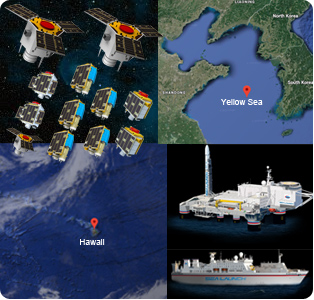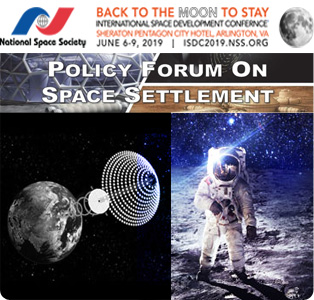China to Attempt Maiden Sea Launch with Long March 11 from Yellow Sea
|
MONDAY Highlights…
|

![]() = All times
= All times
for terrestrial events in local time unless noted.
![]() = All times for international terrestrial events in local time unless noted.
= All times for international terrestrial events in local time unless noted.
![]() = All times for space events, and…
= All times for space events, and…
![]() = All times for international space / astro events in Hawaii Standard Time unless noted. Add 10 hours to obtain UT (‘Universal Time’).
= All times for international space / astro events in Hawaii Standard Time unless noted. Add 10 hours to obtain UT (‘Universal Time’).
Weekly Planet Watch – Evening Planets: Mercury (WNW), Mars (WNW), Jupiter (SE), Saturn (S); Morning Planets: Venus (ENE), Neptune (ESE).
‘Back to the Moon to Stay’ is Theme of 38th International Space Development Conference (ISDC)
National Space Society (NSS) will convene the 2019 ISDC in Arlington, Virginia June 6-9. Occurring annually without interruption since 1982, ISDC brings stakeholders together to ‘work toward a common goal of developing a space-faring civilization’. The nearly exclusively American ‘featured speaker’ roster is replete with notable figures: NASA administrator Jim Bridenstine, Shuttle Commander Eileen Collins, Apollo 15 Astronaut Al Worden, Apollo Mission Control Flight Director Gerry Griffin, Executive Secretary of the National Space Council Scott Pace, Director of Smithsonian National Air and Space Museum Ellen Stofan and Mark Sirangelo, recently resigned former Special Assistant to the NASA Administrator. A Moon Development and Settlement programming track, chaired by Madhu Thangavelu, is to be prominently featured. Preceding the conference, a one-day Policy Forum on Space Settlement is to be held June 5, chaired by Steve Wolfe, Deputy Executive Director of SpaceCom. Michelle L.D. Hanlon, Associate Director of the Air and Space Law Program University of Mississippi, is among the scheduled speakers. Forum topics include current and future space law as it relates to settlement, policy incentives towards private settlement, and the role of government in space settlement. NSS was formed in 1987 through the merger of organizations associated with two luminaries in the history of space thought – Wernher von Braun of the National Space Institute and Gerard O’Neill of the L5 Society. (Image Credits: NSS, ISDC) |
Continued from…
|
TUESDAY
![]() Jun 4 — Space Telescope Science Institute, Baltimore MD: Lecture: Recycle Your Used Pulsars – Explaining the Extra Gamma-Radiation from the Central Milky Way.; by Christopher Britt of STSci.
Jun 4 — Space Telescope Science Institute, Baltimore MD: Lecture: Recycle Your Used Pulsars – Explaining the Extra Gamma-Radiation from the Central Milky Way.; by Christopher Britt of STSci.
![]() Jun 4-7— Institute for Space Astrophysics and Planetology (INAF-IAPS), Sardinia, Italy: The Main Belt: A Gateway to the Formation and Early Evolution of the Solar System.
Jun 4-7— Institute for Space Astrophysics and Planetology (INAF-IAPS), Sardinia, Italy: The Main Belt: A Gateway to the Formation and Early Evolution of the Solar System.
![]() Jun 4-7 — Canaveral Council of Technical Societies, NASA Kennedy Space Center, Space Florida, Economic Development Commission of Florida Space Coast, Cape Canaveral FL: 46th Space Congress: Light the Fire.
Jun 4-7 — Canaveral Council of Technical Societies, NASA Kennedy Space Center, Space Florida, Economic Development Commission of Florida Space Coast, Cape Canaveral FL: 46th Space Congress: Light the Fire.
![]() Jun 4 — Moon: 3.7° S of Mercury, 07:00.
Jun 4 — Moon: 3.7° S of Mercury, 07:00.
![]() Jun 4 — Apollo Asteroid 2019 KY: Near-Earth Flyby (0.014 AU)
Jun 4 — Apollo Asteroid 2019 KY: Near-Earth Flyby (0.014 AU)
![]() Jun 4 — Apollo Asteroid 2019 KS: Near-Earth Flyby (0.031 AU)
Jun 4 — Apollo Asteroid 2019 KS: Near-Earth Flyby (0.031 AU)
![]() Jun 4 — Aten Asteroid 2014 JU15: Near-Earth Flyby (0.100 AU)
Jun 4 — Aten Asteroid 2014 JU15: Near-Earth Flyby (0.100 AU)
WEDNESDAY
![]() Jun 5 — China Aerospace Science and Technology Corporation, Launch Long March 11 / Jilin 1, Launch Vessel, Yellow Sea: Long March 11, dubbed CZ-11 WEY, to loft two Jilin-1 Earth observation satellites from launch platform in Yellow Sea on China first sea-based orbital launch attempt.
Jun 5 — China Aerospace Science and Technology Corporation, Launch Long March 11 / Jilin 1, Launch Vessel, Yellow Sea: Long March 11, dubbed CZ-11 WEY, to loft two Jilin-1 Earth observation satellites from launch platform in Yellow Sea on China first sea-based orbital launch attempt.
![]() Jun 5 — SpaceX, Launch Falcon 9 / Amos 17, Cape Canaveral, FL: Falcon 9 to launch Amos 17 communications satellite to provide broadband connectivity over Africa, Middle East and Europe.
Jun 5 — SpaceX, Launch Falcon 9 / Amos 17, Cape Canaveral, FL: Falcon 9 to launch Amos 17 communications satellite to provide broadband connectivity over Africa, Middle East and Europe.
![]() Jun 5 — National Space Society, Arlington VA: ISDC Pre-Conference Event: Policy Forum on Space Settlement; with Michelle Hanlon, Tony DeTora, Sagi Kfir, Kevin O’Connell, Hoyt Davidson.
Jun 5 — National Space Society, Arlington VA: ISDC Pre-Conference Event: Policy Forum on Space Settlement; with Michelle Hanlon, Tony DeTora, Sagi Kfir, Kevin O’Connell, Hoyt Davidson.
![]() Jun 5 — Mars Exploration Program Analysis Group (MEPAG), NASA, Online / Washington DC: 5th MEPAG Virtual Meeting.
Jun 5 — Mars Exploration Program Analysis Group (MEPAG), NASA, Online / Washington DC: 5th MEPAG Virtual Meeting.
![]() Jun 5-6 — University of Grenoble Alpes, Grenoble, France: Workshop: Societal Impacts of Research on Extraterrestrial Life and Studies on the Origin of Life.
Jun 5-6 — University of Grenoble Alpes, Grenoble, France: Workshop: Societal Impacts of Research on Extraterrestrial Life and Studies on the Origin of Life.
![]() Jun 5 — Moon: 1.60° S of Mars, 06:00.
Jun 5 — Moon: 1.60° S of Mars, 06:00.
THURSDAY
![]() Jun 6 — University of Oxford, Oxford, United Kingdom: Lecture: Finding Aliens – An Update on the Search for Life in the Universe; by Bill Diamond, President & CEO of SETI Institute.
Jun 6 — University of Oxford, Oxford, United Kingdom: Lecture: Finding Aliens – An Update on the Search for Life in the Universe; by Bill Diamond, President & CEO of SETI Institute.
![]() Jun 6-9 — National Space Society, Arlington VA: International Space Development Conference 2019 (ISDC19): Back to the Moon to Stay; at Sheraton Pentagon City Hotel.
Jun 6-9 — National Space Society, Arlington VA: International Space Development Conference 2019 (ISDC19): Back to the Moon to Stay; at Sheraton Pentagon City Hotel.
![]() Jun 6 — Moon: 6.2° S of Pollux, 00:00.
Jun 6 — Moon: 6.2° S of Pollux, 00:00.
![]() Jun 6 — Aten Asteroid 2014 MF18: Near-Earth Flyby (0.022 AU)
Jun 6 — Aten Asteroid 2014 MF18: Near-Earth Flyby (0.022 AU)
![]() Jun 6 — Amor Asteroid 2019 JX2: Near-Earth Flyby (0.035 AU)
Jun 6 — Amor Asteroid 2019 JX2: Near-Earth Flyby (0.035 AU)
FRIDAY
![]() Jun 7 — Japan Society for the Promotion of Science, AAAS, NAOJ, NSF, et al, Washington DC: 24th JSPS “Science in Japan” Forum.
Jun 7 — Japan Society for the Promotion of Science, AAAS, NAOJ, NSF, et al, Washington DC: 24th JSPS “Science in Japan” Forum.
![]() Jun 7 — Caltech Astronomy Department, Pasadena CA: Lecture: We Were the Discoverers – Witnessing the Exoplanet Revolution.
Jun 7 — Caltech Astronomy Department, Pasadena CA: Lecture: We Were the Discoverers – Witnessing the Exoplanet Revolution.
![]() Jun 7 — Moon: at perigee (distance 368,019 km), 13:16.
Jun 7 — Moon: at perigee (distance 368,019 km), 13:16.
![]() Jun 7 — Apollo Asteroid 2017 BM93: Near-Earth Flyby (0.086 AU)
Jun 7 — Apollo Asteroid 2017 BM93: Near-Earth Flyby (0.086 AU)
SATURDAY
![]() Jun 8 — Mt Tam Astronomy Nights, San Francisco Amateur Astronomers and Wonderfest, Mt. Tamalpais State Park CA: Lecture: Gravitational Lensing: Bends in Spacetime; by Fatima Abdurrahman from UC Berkeley.
Jun 8 — Mt Tam Astronomy Nights, San Francisco Amateur Astronomers and Wonderfest, Mt. Tamalpais State Park CA: Lecture: Gravitational Lensing: Bends in Spacetime; by Fatima Abdurrahman from UC Berkeley.
![]() Jun 8 — Griffith Observatory, Los Angeles CA: Griffith Observatory Public Star Party.
Jun 8 — Griffith Observatory, Los Angeles CA: Griffith Observatory Public Star Party.
![]() Jun 8 — Moon: 3.0° NNE of Regulus, 12:00.
Jun 8 — Moon: 3.0° NNE of Regulus, 12:00.
![]() Jun 8 — Venus: 5.1° SSE of Pleiades, 19:00.
Jun 8 — Venus: 5.1° SSE of Pleiades, 19:00.
SUNDAY
![]() Jun 9-11 — Secure World Foundation, Prague Security Studies Institute, Prague, Czech Republic: 5th PSSI Space Security Conference.
Jun 9-11 — Secure World Foundation, Prague Security Studies Institute, Prague, Czech Republic: 5th PSSI Space Security Conference.
![]() Jun 9-13 — American Astronomical Society, St. Louis MO: 234th AAS Meeting with Laboratory Astrophysics Division & Solar Physics Division.
Jun 9-13 — American Astronomical Society, St. Louis MO: 234th AAS Meeting with Laboratory Astrophysics Division & Solar Physics Division.
![]() Jun 9 — Moon: At first quarter, 19:59.
Jun 9 — Moon: At first quarter, 19:59.
![]() Jun 9 — Apollo Asteroid 2017 XY2: Near-Earth Flyby (0.074 AU)
Jun 9 — Apollo Asteroid 2017 XY2: Near-Earth Flyby (0.074 AU)

